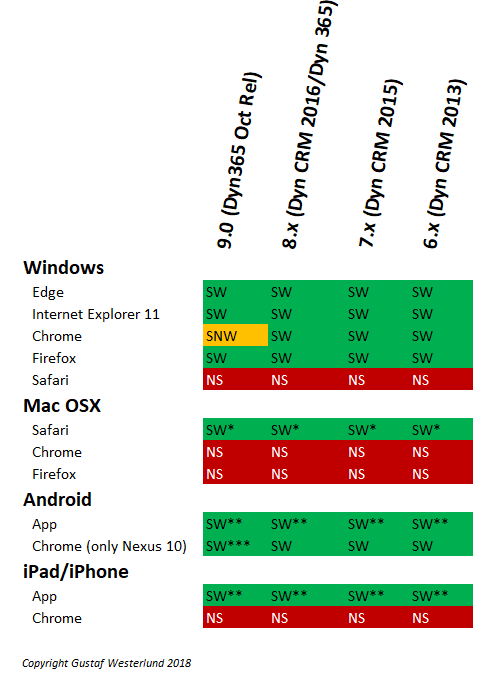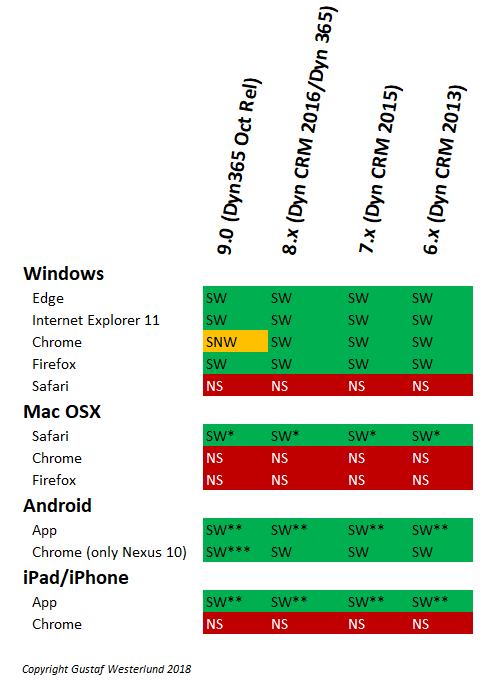
by gustaf | Apr 9, 2018
In case you haven’t seen it, the Dynamics 365 Admin Portal it is a great place to create and manage you Dynamics 365 tickets.
You get to it using this URL: https://admin.dynamics.com/
I haven’t found a link to the admin portal from the instance manger or any other place in O365 or Dyn365 yet so I have just created a bookmark for it, so I suggest you do the same.
Also, as I am a frequent Microsoft Support user, and often have customers with many instances, I have tried to consolidate many instances into one ticket. They don’t want that. Better to create one ticket for each instance. (probably gets someone a higher salary too :)) However, I did notice that there seems to be some duplicate detection going on, so try to avoid using the same “Issue Summary” for several tickets – as that will just make the later ones disappear without any error message (hint Microsoft, please fix this! – at least give a decent error message).
In order to create tickets, you need to be either O365 Global Admin or Dynamics 365 Service Administrator. There might be some other admin as well that has the right to create tickets, but I don’t think so.
Gustaf Westerlund
MVP, Founder and Principal Consultant at CRM-konsulterna AB
www.crmkonsulterna.se

by gustaf | Feb 4, 2018
One of my most popular posts is a collation on which browsers are actually supported for Dynamics 365 CE. This is not strange since it is a common issue, we often have customers call our support complaining that Dynamics doesn’t work well, and as described in the original article, the cause is usually that they are using an unsupported browser.
Also the Micrsoft Technet article for this: https://docs.microsoft.com/en-us/dynamics365/customer-engagement/admin/supported-web-browsers-and-mobile-devices
and the detailed version: https://technet.microsoft.com/en-us/library/hh699710.aspx mainly focuses on Edge and Internet Explorer compatibility for the different windows versions. And despite Microsoft’s hopes, the rest of the world have not totally turned to all of their programs, yet.
There are currently some issues with version 9.0 as well, why I thought it might be a good idea to write a new article on which browsers are the supported one in a easily overviewable grid.
A brief explanation to the different abbreviations used in the picture:

- SW – Supported and Working.
- SW* – Supported and Working on OS X as designed but with somewhat limited functionality. If you compare Dynamics on OS X running Safari with it running Edge on a Win 10 you will notice that there are more options.
- SW** – The app is not the same thing as the browser at the moment. The Unified Interface will make them almost the same. There will still be differences, in that the app will have better integrations to the device’s hardware, like camera, etc. Especially for the earlier versions, the app was very limited. It is more powerful know. For field service there is also a special Field Service App which is not as HTML/JS based (it is based on Resco).
- SW*** – I have not had the chance to test if version 9.0 works on a Nexus 10 running Chrome but the official documentation says it should work. However, as v.9.0 does not work with Chrome at the moment, (this will probably be fixed very soon) I would actually be surprised if it worked for Chrome on Nexus 10.
- NS – Not supported. This does not mean, however, that you cannot get it to work. I have heard of people that mange to get Chrome on OS X to go into some “PC” mode which tricks Dynamics. This still doesn’t make it supported, but it might work for you. The problem might be if you have any issues, that Microsoft Support could leave you hanging.
- SNW – Supported but Not Working – As for Chrome on Windows, the general story is that Microsoft only support the latest version of it. However, despite version 9.0 official supporting Chrome on Windows, it doesn’t seem to actually work. I would presume that they will fix this soon. The problem is that Dynamics 365 won’t actually load.
The support matrix for the browsers is generally a tricky question. The matrix above is also simplified a bit as I have not included the parameter of the different versions of Operating systems. It can probably be presumed that Microsoft will make greater efforts into making sure that the latest and possibly even some versions before that, that they know customers are using for Edge and Internet Explorer, work well with Dynamics 365. I know some of you will probably think I am crazy for even mentioning Internet Explorer, but I have several customers who still have IE as the company standard browser, and it is not due to Dynamics 365.
As for Firefox, Chrome and Safari, these browsers might be very popular, but from a Microsoft perspective I can see a very tricky situation, and that is that they roll out changes without notifying anyone. This was, for instance, done by Google a couple of years ago when they changed their handling of modal dialogs. This caused many dialog handling features of Dynamics CRM (at that time) to break. It took some time for Microsoft to identify the change, fix it, make sure there were no regression errors, roll it through all testing scenarios and deployment stages and controlls they do until they were able to get a fix out. It did come out quite fast, but there were some people nagging at Microsoft for having a bad product, which I personally find a bit unfair.
The essence of the two paragraphs above is; feel free to use Chrome, Safari or Firefox but I would suggest always having Edge and/or IE as a backup option in the case that an update comes to the main browser that severely affects the usage of Dynamics 365.
And I hope that Microsoft soon fixes the error that stops us from using Chrome with ver. 9.0. Any day now!
Gustaf Westerlund
MVP, Founder and Principal Consultant at CRM-konsulterna AB
www.crmkonsulterna.se

by gustaf | Nov 29, 2017
If you are using Dynamics 365 Online, Dynamics 365 Support is your IT-department for your Dynamics system and you need to know or start learning how to working with them in a good way. There are several things you should consider.
Registering a support ticket
First of all, registering a support ticket is of course important. This might not be as trivial as it seems, as it depends on which type of license you have. If you have bought your licenses using CSP (Cloud Service Provider) or Select/Volume Licensing then you will most probably be directed to your CSP/Select partner for any support issues. You can of course buy premier support from Microsoft but that might not always be an option for smaller companies. There are some tricks as well if you are stuck with CSP/Select or similar, and will be happy to tell you about these in person if I meet you, but I won’t write about them, as I am afraid it will be “fixed” which would be sad.
If you have bought your licenses directly through the O365 portal, you can also create a ticket using the portal. You need to be a Global Admin or a Dynamics 365 Service Admin to place a ticket. Currently you cannot indicate that the ticket is for Dynamics so you simply write so in the text and the O365 support team will create a new Dynamics 365 ticket for you. I was amazed at how fast the Office 365 support called me after registering a ticket, I think it took less than 1 minute. So I would suggest you choose the option “call me”.
If you have a partner, I strongly suggest that you register them in the Office 365 portal for the Dynamics 365 subscription as Partner of Record (PoR). This will make your company show up in their Microsoft partner portal where they can register a support ticket for you.
Checklist
When registering the ticket with Microsoft, there are some things you have to note:
- Be polite. Even if your system is slower than sirup in January (a Swedish saying) or nobody can log in, you will not be getting any help faster by screaming or being rude. I like to quote my grandfather who had a good saying: “Better to be strong in argument and withheld in words, than the other way round.” I have actually gotten written compliments for being nice by the support people, do you think they will go the extra mile for me?
- Be very exact with what is you think is wrong. The best way is to formulate it like this: “I did X and expected Y but I got Z”. Also be clear on when you define the case as closed. This is particularly important, and hard when you have performance issues or intermittent errors. But try to be as exact as you can. For example: “When users run Chrome open a Contact (after the contact form already has been loaded for another record) it takes 10 seconds. We expect it to take no more than 2 seconds.”
- Only have one issue per ticket. Better to have many tickets open. I have had 4 tickets open for one single customer at the same point in time.
- If you think the issue is important, describe it in business impact terms. For example “The bug X affects all sales people in the organization effectivly stopping them from using Dynamics 365. It severly risks our entire Dynamics 365 investment as users look at other solutions and the user adoption drops dramatically and the trust in the system is drastically lowered for every hour this bug is not fixed. We have 4354 sales people in our global sales organization spread out over 34 countries. It also affects managements abilities to manage the company as no pipleline and forecast numbers are produced which could potentially cause sever business damages that cannot easily be fixed within the coming 4-5 years.” – This was just made up 🙂 but it is important to not hold back when doing this, especially if you are Swedish or from other cultures which value humbleness.
- Be clear on limits of the error.
- Which Operating system?
- Which browsers?
- What times? Can you see any clear patterns on when it happens?
- Geos?
- Security roles?
- Types of users affected, AD users federated to O365 or Cloud users?
- How long?
- Which versions of Dynamics 365 are you running?
- Which instances have the issue (the url:s)?
Types of tickets
What types of tickets can be registered? Should you only register a ticket when you want help with something?
Well, no, you can and should register a ticket for many different reasons. As I mentioned at the top of the article it is important to think about Microsoft Support as your Dynamics 365 IT-department. They will help you with a lot of things that your IT-department would have helped you with had they hosted your Dynamics system. The main difference is probably that they do nothing else than host Dynamics 365, every day, year after year… not many IT-departments that can compare with that.
Typical issues they can help out with are:
- Something seems to have stopped working that used to work, and you didn’t change anything. Like you cannot create an Application User anymore.
- Something clearly is a bug in Dynamics 365 and you want Microsoft to know about it (they might not know) and you want to let them know how important it is for you (they will surely not know this).
- You need some information from the Server, like the “Top 10 table Usage” report from the SQL database.
- You have performance issues.
- You need to change the planned upgrades because your team won’t make the set time.
- You want to set some non-clustered indexes on the database.
- You are doing a migration of large amounts of data and you will be a bad neighbour for a few days and if possible you would like a little more than the 2 allocated threads in the API.
- You want a database copy prepared for installation into an on-prem equivalent.
- You need some detailed information on how the service is managed, like
- How backups are stored
- How to restore backups from the 90 day tape backup
- Where an instance is hosted
- You would like to move an instance to another datacenter
- You need to remove a managed solution but it has dependencies that shouldn’t be there…
- You need to do some task with an instance that you cannot do yourself with the instance manager.
In other words, they will be your superfriend when working with Dynamics 365 and you want to be really nice to your super friend!
Gustaf Westerlund
MVP, Founder and Principal Consultant at CRM-konsulterna AB
www.crmkonsulterna.se








Recent Comments